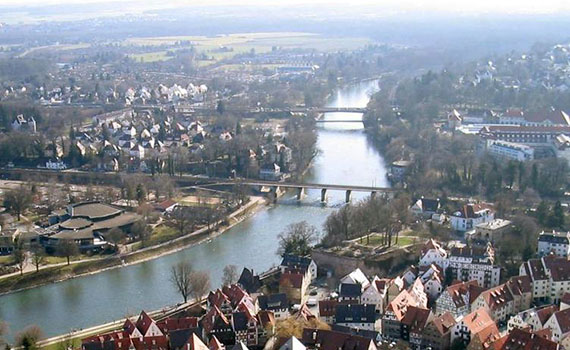
The Danube flowing through the German city of Ulm. The river, which passes through 10 countries, was the focus of a recent symposium at Colgate University. (Photo by Patrick Sauter)
In one weekend, Alexa Windsor ’13 , a double major in German and history, had access to more academic gravitas in her field than many students have in four years of college.
She attended the recent Black and Blue Danube symposium, which featured film screenings, a student poster session, and three panels showcasing a dozen academic papers by leading scholars from Colgate and elsewhere. They came together to collaborate and discuss the historical and metaphorical impacts of Europe’s second-longest river.
“The black and blue symposium was absolutely brilliant,” said Windsor, of Birmingham, Ala. “I am currently in a seminar on Vienna at the turn of the 20th Century, so many of the lectures thoroughly deepened my understanding of that culture.”
Marijeta Bozovic, assistant professor of Russian and Eurasian studies, said the event was created as a result of professors at Colgate from across disciplines discussing the creative intersections of their work.
“Working and living in this small community of scholars ‘forces’ us to work and collaborate across — not only within — our fields, sub fields, and disciplines,” said Bozovic. She developed the symposium idea with Assistant Professor of German Matthew Miller, Visiting Assistant Professor of Art & Art History and Film & Media Studies Jennifer Stob, and Visiting Instructor in German Bill Martin.
The resulting series of panels and lectures examined themes of nationhood and transnational circulation, history and trauma, pollution and purity, and the transgression of boundaries as they relate to the river.
The Danube directly connects ten countries and is a watershed for four more, but the region through which the river travels receives little scholarly attention, Bozovic said.
“All of the papers presented, and I mean every single one, was of such high quality and inherently interesting,” Bozovic said. “On top of that, there was such a high degree of generosity in the room. The scholars present really showed themselves willing to meet each other halfway, or part way, outside of their own areas of expertise, and in order to engage each others work.”
The symposium was co-sponsored by the departments of Russian & Eurasian Studies, German, Art & Art History, Film & Media Studies, Geography, History, Political Science, the Office of the Dean of Faculty, and the Central New York Humanities Corridor, a regional collaborative of universities and colleges funded by the Andrew W. Mellon Foundation.